The Bulldozer Review: AMD FX-8150 Tested
by Anand Lal Shimpi on October 12, 2011 1:27 AM ESTPower Management and Real Turbo Core
Like Llano, Bulldozer incorporates significant clock and power gating throughout its design. Power gating allows individual idle cores to be almost completely powered down, opening up headroom for active cores to be throttled up above and beyond their base operating frequency. Intel's calls this dynamic clock speed adjustment Turbo Boost, while AMD refers to it as Turbo Core.
The Phenom II X6 featured a rudimentary version of Turbo Core without any power gating. As a result, Turbo Core was hardly active in those processors and when it was on, it didn't stay active for very long at all.
Bulldozer's Turbo Core is far more robust. While it still uses Llano's digital estimation method of determining power consumption (e.g. the CPU knows ALU operation x consumes y-watts of power), the results should be far more tangible than what we've seen from any high-end AMD processor in the past.
Turbo Core's granularity hasn't changed with the move to Bulldozer however. If half (or fewer) of the processor cores are active, max turbo is allowed. If any more cores are active, a lower turbo frequency can be selected. Those are the only two frequencies available above the base frequency.
AMD doesn't currently have a Turbo Core monitoring utility so we turned to Core Temp to record CPU frequency while running various workloads to measure the impact of Turbo Core on Bulldozer compared to Phenom II X6 and Sandy Bridge.
First let's pick a heavily threaded workload: our x264 HD benchmark. Each run of our x264 test is composed of two passes: a lightly threaded first pass that analyzes the video, and a heavily threaded second pass that performs the actual encode. Our test runs four times before outputting a result. I measured the frequency of Core 0 over the duration of the test.
Let's start with the Phenom II X6 1100T. By default the 1100T should run at 3.3GHz, but with half or fewer cores enabled it can turbo up to 3.7GHz. If Turbo Core is able to work, I'd expect to see some jumps up to 3.7GHz during the lightly threaded passes of our x264 test:
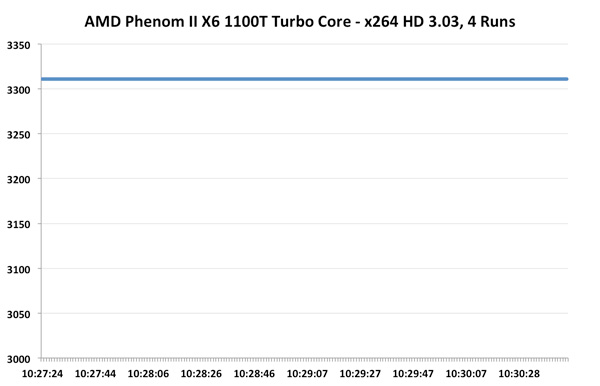
Unfortunately we see nothing of the sort. Turbo Core is pretty much non-functional on the Phenom II X6, at least running this workload. Average clock speed is a meager 3.31GHz, just barely above stock and likely only due to ASUS being aggressive with its clocking.
Now let's look at the FX-8150 with Turbo Core. The base clock here is 3.6GHz, max turbo is 4.2GHz and the intermediate turbo is 3.9GHz:
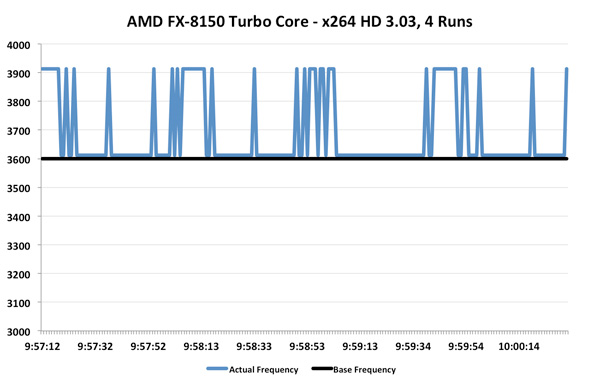
Ah that's more like it. While the average is only 3.69GHz (+2.5% over stock), we're actually seeing some movement here. This workload in particular is hard on any processor as you'll see from Intel's 2500K below:
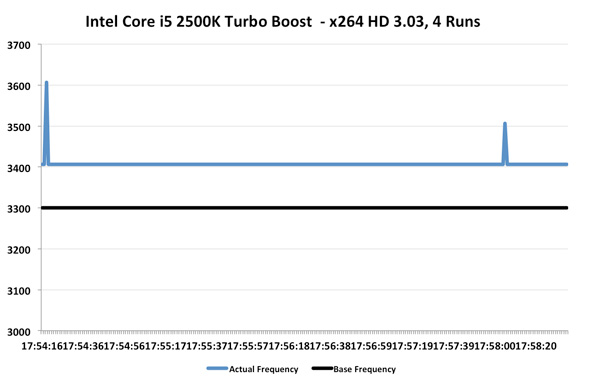
The 2500K runs at 3.3GHz by default, but thanks to turbo it averages 3.41GHz for the duration of this test. We even see a couple of jumps to 3.5 and 3.6GHz. Intel's turbo is a bit more consistent than AMD's, but average clock increase is quite similar at 3%.
Now let's look at the best case scenario for turbo: a heavy single threaded application. A single demanding application, even for a brief period of time, is really where these turbo modes can truly shine. Turbo helps launch applications quicker, make windows appear faster and make an easy time of churning through bursty workloads.
We turn to our usual favorite Cinebench 11.5, as it has an excellent single-threaded benchmark built in. Once again we start with the Phenom II X6 1100T:
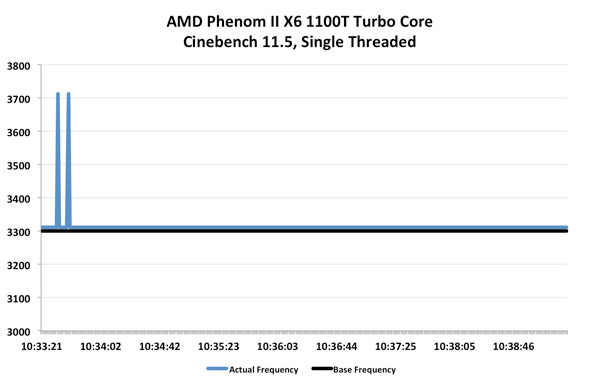
Turbo Core actually works on the Phenom II X6, albeit for a very short duration. We see a couple of blips up to 3.7GHz but the rest of the time the chip remains at 3.3GHz. Average clock speed is once again, 3.31GHz.
Bulldozer does far better:

Here we see blips up to 4.2GHz and pretty consistent performance at 3.9GHz, exactly what you'd expect. Average clock speed is 3.93GHz, a full 9% above the 3.6GHz base clock of the FX-8150.

Intel's turbo fluctuates much more frequently here, moving between 3.4GHz and 3.6GHz as it runs into TDP limits. The average clock speed remains at 3.5GHz, or a 6% increase over the base. For the first time ever, AMD actually does a better job at scaling frequency via turbo than Intel. While I would like to see more granular turbo options, it's clear that Turbo Core is a real feature in Bulldozer and not the half-hearted attempt we got with Phenom II X6. I measured the performance gains due to Turbo Core across a number of our benchmarks:

Average performance increased by just under 5% across our tests. It's nothing earth shattering, but it's a start. Don't forget how unassuming the first implementations of Turbo Boost were on Intel architectures. I do hope with future generations we may see even more significant gains from Turbo Core on Bulldozer derivatives.
Independent Clock Frequencies
When AMD introduced the original Phenom processor it promised more energy efficient execution by being able to clock each core independently. You could have a heavy workload running on Core 0 at 2.6GHz, while Core 3 ran a lighter thread at 1.6GHz. In practice, we felt Phenom's asynchronous clocking was a burden as the CPU/OS scheduler combination would sometimes take too long to ramp up a core to a higher frequency when needed. The result, at least back then, was that you'd get significantly lower performance in these workloads that shuffled threads from one core to the next. The problem was so bad that AMD abandoned asynchronous clocking altogether in Phenom II.
The feature is back in Bulldozer, and this time AMD believes it will be problem free. The first major change is with Windows 7, core parking should keep some threads from haphazardly dancing around all available cores. The second change is that Bulldozer can ramp frequencies up and down much quicker than the original Phenom ever could. Chalk that up to a side benefit of Turbo Core being a major part of the architecture this time around.
Asynchronous clocking in Bulldozer hasn't proven to be a burden in any of our tests thus far, however I'm reluctant to embrace it as an advantage just yet. At least not until we've had some more experience with the feature under our belts.


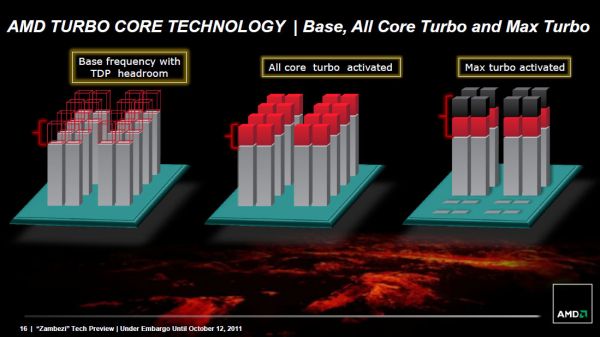








430 Comments
View All Comments
actionjksn - Thursday, October 13, 2011 - link
AMD Nailpuller? That was some funny shit right there HA HA HASpam not Spam - Wednesday, October 12, 2011 - link
Just skimmed the review; not as awesome as I had hoped for, sadly. That being said, I'm thinking it might well be a nice improvement for the stock, C2D Q6600 in my Dell. I could go Intel, obviously, but... I dunno. I've got an odd fascination with novel things, even if they are rough to begin with. Hell, I've even got a WP7 phone :pwolfman3k5 - Wednesday, October 12, 2011 - link
Then make sure to get a quality power supply and motherboard to go with it. Also, your power bill will increase, but not directly from the Bulldozer CPU, nope, but from all the heat that it will make... you will need to run your air conditioner which is a power hog./* Patiently waiting for AMD's next gen architecture codenamed "Bendover" */
ckryan - Wednesday, October 12, 2011 - link
Is 'ScrewdOver' next on the roadmap after 'Bendover'? I'll have to look in the official AMD leaked slide repository.I still think some intrepid AMD faithful will try BD out just because they're wired that way, and many of the are going to like it. I bet it compares better to Lynnfield than Sandy Bridge... Except Ivy Bridge is closer in the future than SB's launch is in the past. This could be an interesting and relevant product after a few years, but the need is dire now. AMD is going to kill off the Phenom II as fast as possible.
themossie - Wednesday, October 12, 2011 - link
Bendover -> ScrewdOver -> Screwdriver (I'll bring the OJ) -> Piledriver.Courtesy of numerous internal leaks at AMD.
themossie - Wednesday, October 12, 2011 - link
My apologies, didn't realize Piledriver was real.bill4 - Wednesday, October 12, 2011 - link
AKA, the reason all of us who are commenting are reading this review. Gaming performance. And AMD chose not to even compete there. Bunch of monkey overs at AMD CPU engineering?It's now a non starter in the enthusiast market.
I've often though recently that AMD (or any manufacturer really, but AMD as a niche filler would be a more obvious choice given their market position) would do well to try to position itself as the gamers choice, and even design it's CPU's to excel in gaming at the expense of some other things at times. I really suspect this strategy would lead to a sales bonanza. Because really the one area consumers crave high performance is pretty much, only gaming. It's the one reason you actually want a really high performance CPU (provided you dont do some sort of specialized audio/video work), instead of just "good enough" which is fine for general purpose desktoping.
Instead they do the exact opposite with Bulldozer, facepalm. Bulldozer is objectively awful in gaming. Single handedly nobody who posts at any type of gaming or gaming related forum will ever buy one of these. Unbelievable.
Perhaps making it even more stinging is there was some pre-NDA lift supposed reviewer quote floating around at about how "Bulldozer will be the choice for gamers" or something like that. And naturally everybody got excited because, that's all most people care about.
Combine that with the fact it's much bigger and hotter than Intel's, it's almost a unmitigated disaster.
This throws AMD's whole future into question since apparently their future is based on this dog of a chip, and even makes me wonder how long before AMD's engineers corrupt the ATI wing and bring the GPU side to disaster? The ONLY positive thing to come out of it is that at least AMD is promising yearly improvements, key word promising. Even then absolute best case scenario is that they slowly fix this dog in stages, since it's clearly a broken architecture. And that's best case, and assumes they will even meet their schedule.
Anand lays so much of the blame at clockspeed, hinting AMD wanted much more. But even say, 4.3 ghz Bulldozer, would STILL be a dog in all important gaming, so there's little hope.
shompa - Wednesday, October 12, 2011 - link
I have used many AMD systems. Have deployed 1000 of AMD CPU inside Unix workstations at my old work. I cheer for AMD.But.
AMD is going to have a hard time ahead. Selling its fabs to Global foundries was the biggest mistake of them all.
We are in the post PC world. If Tablets are computers: 2012 20% of PCs will use ARM. This is many lost CPU sales for AMD/Intel.
I predict that AMD will be gone within 3 years. Maybe someone buys them? After the settlement with Intel, AMD now can transfer its X86 license to the next buyer. (pending Intels approval)
Maybe Google could buy AMD and build complete computers ?
wolfman3k5 - Wednesday, October 12, 2011 - link
I see two things that might happen to AMD1) They will transform in to a GPU manufacturer completely (and of course they will make those silly APUs)
2) If that damn x86 license is transferable, they could merge with NVidia. Neither of these two companies looks to hot these days, so they might as well work together.
philosofool - Thursday, October 13, 2011 - link
We may be in the "post PC" era, but don't count x86 out. Recent studies indicate there's a corollary to Moore's law that applies to compute power per watt; the study goes back to 1961. This suggests that x86 is only a few years away from running on mobile devices, which is what MS and Intel are betting on. And frankly, it makes sense. Ultimately, I don't want two different things (a mobile device and a PC), I want a PC in my pocket and one on my desk.